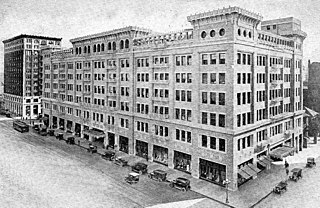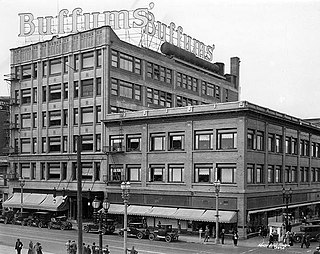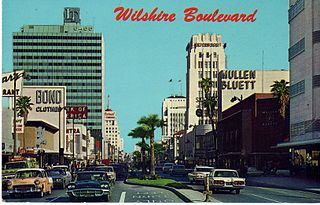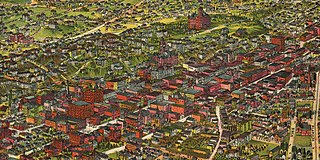Related Research Articles

Broadway, until 1890 Fort Street, is a thoroughfare in Los Angeles County, California, United States. The portion of Broadway from 3rd to 9th streets, in the Historic Core of Downtown Los Angeles, was the city's main commercial street from the 1910s until World War II, and is the location of the Broadway Theater and Commercial District, the first and largest historic theater district listed on the National Register of Historic Places (NRHP). With twelve movie palaces located along a six-block stretch of Broadway, it is the only large concentration of movie palaces left in the United States.

J. W. Robinson Co., Robinson's, was a chain of department stores operating in the Southern California and Arizona area, previously with headquarters in Los Angeles, California.
I. Magnin & Company was a San Francisco, California-based high fashion and specialty goods luxury department store. Over the course of its existence, it expanded across the West into Southern California and the adjoining states of Arizona, Oregon, and Washington. In the 1970s, under Federated Department Stores ownership, the chain entered the Chicago, and Washington, D.C., metropolitan areas. Mary Ann Magnin founded the company in 1876 and named the chain after her husband Isaac.

May Company California was an American chain of department stores operating in Southern California and Nevada, with headquarters at its flagship Downtown Los Angeles store until 1983 when it moved them to North Hollywood. It was a subsidiary of May Department Stores and merged with May's other Southern California subsidiary, J. W. Robinson's, in 1993 to form Robinsons-May.

Buffums, originally written as Buffums' with an apostrophe, was a chain of upscale department stores, headquartered in Long Beach, California. The Buffums chain began in 1904, when two brothers from Illinois, Charles A. and Edwin E. Buffum, together with other partners, bought the Schilling Bros., the largest dry goods store in Long Beach, and renamed it The Mercantile Co. The store grew to a large downtown department store, and starting in the 1950s, grew slowly over the years to be a small regional chain of 16 speciality department stores across Southern California at the time of its closure in 1990.

The Metropolitan Building, in Los Angeles, California, was completed in 1913 and is one of a number of buildings built along Broadway in the early decades of the twentieth century for commercial and retail uses in what had then become the busiest and largest shopping district of the city. Located at the intersection of W. 5th Street and S. Broadway, the Metropolitan Building replaced a two-story, Romanesque Revival style building with storefronts on S. Broadway and W. 5th Street. This building was called the Mueller Building for its owner, Michail Mueller. The date of the building's construction is not known, nor has any additional information about it been located.
Edison Brothers Stores, Inc., was a retail conglomerate based in St. Louis, Missouri. It operated numerous retail chains mainly located in shopping malls, mostly in the fields of shoes, clothing and entertainment, with Bakers Shoes as its flagship chain. The company was liquidated in 1999, though some of the chains it operated continued under different owners.
Mandel's was a chain of shoe stores in the Southwestern United States for many decades of the 20th century. For a time it advertised its wares as "Mandel's Fascinating Slippers". Maurice Mandel headed up the stores through the 1930s, 1940s and 1950s. Later Mandel would later serve as General Merchandise Manager (GMM) of chain Mullen & Bluett and president of Harris & Frank. Among its branches were:

Harris & Frank was a clothing retailer and major chain in the history of retail in Southern California, which at its peak had around 40 stores across Southern California and in neighboring states and regions. Its history dates back to a clothing store founded by Leopold Harris in Los Angeles in 1856 near the city's central plaza, only eight years after the city had passed from Mexican to American control. Herman W. Frank joined Harris in partnership 32 years later in 1888.

Coulter's was a department store that originated in Downtown Los Angeles and later moved to the Miracle Mile shopping district in that same city.

Phelps-Terkel was a Los Angeles based department store specializing in men's clothing.

The Famous Department Store was a department store in Los Angeles, California.
Nahas was a chain of department stores owned by A. S. Nahas, operating in Greater Los Angeles, carrying clothing, household goods and electronics. They also acquired Rathbun's department store at 5311 Lankershim Boulevard in North Hollywood and cobranded it "Nahas Rathbuns" before the branch closed in 1980. The remaining Nahas stores were closed from 1981 to 1982.

The late-Victorian-era Downtown of Los Angeles in 1880 was centered at the southern end of the Los Angeles Plaza area, and over the next two decades, it extended south and west along Main Street, Spring Street, and Broadway towards Third Street. Most of the 19th-century buildings no longer exist, surviving only in the Plaza area or south of Second Street. The rest were demolished to make way for the Civic Center district with City Hall, numerous courthouses, and other municipal, county, state and federal buildings, and Times Mirror Square. This article covers that area, between the Plaza, 3rd St., Los Angeles St., and Broadway, during the period 1880 through the period of demolition (1920s–1950s).

7th Street is a street in Los Angeles, California running from S. Norton Ave in Mid-Wilshire through Downtown Los Angeles. It goes all the way to the eastern city limits at Indiana Ave., and the border between Boyle Heights, Los Angeles and East Los Angeles.

Boadway Bros. or Boadway's was a chain of upscale department stores in Southern California and New Mexico during the 1910s and 1920s, which started with a single store in Pasadena carrying furniture.

Retail in Southern California dates back to its first dry goods store that Jonathan Temple opened in 1827 on Calle Principal, when Los Angeles was still a Mexican village. After the American conquest, as the pueblo grew into a small town surpassing 4,000 population in 1860, dry goods stores continued to open, including the forerunners of what would be local chains. Larger retailers moved progressively further south to the 1880s-1890s Central Business District, which was later razed to become the Civic Center. Starting in the mid-1890s, major stores moved ever southward, first onto Broadway around 3rd, then starting in 1905 to Broadway between 4th and 9th, then starting in 1915 westward onto West Seventh Street up to Figueroa. For half a century Broadway and Seventh streets together formed one of America's largest and busiest downtown shopping districts.
Market Basket was the name used by two separate chains of supermarkets within Southern California. The first chain originated in Pasadena and operated from 1930 until 1982. The second chain operated from 1989 until 1994.

The Weatherby-Kayser Shoe Company was a chain of footwear retailers with origins in Los Angeles in the early 1900s. It was founded in 1884 by Bruce Weatherby and Emil Kayser.
References
- ↑ "C H Baker". Los Angeles Herald. 6 September 1908. p. 5. Retrieved 22 April 2024.
- ↑ "Charles Harris Baker (Obituary)". Los Angeles Times. 23 August 1939. p. 20. Retrieved 22 April 2024.
- 1 2 "Head of Shoe Company Dies (1/1)". The Los Angeles Times. 23 August 1939. p. 21. Retrieved 22 April 2024.
- 1 2 "C. H. Baker Anniversary Section: Celebrated Fifth Anniversary in Hollywood". Los Angeles Evening Citizen News. 28 September 1928. p. 13. Retrieved 22 April 2024.
- ↑ "Hamilton & Baker, 239 S. Spring St., dissolved partnership. C. H. Baker will continue the business". Los Angeles Evening Post-Record. 26 February 1904. p. 6. Retrieved 22 April 2024.